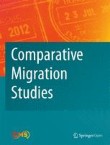Volumes 1 and 2 of Comparative Migration Studies are available here
Struggles for democracy: strategies and resources of initiatives for non-citizen voting rights at local levels in Europe
This paper deals with non-citizen voting rights from the perspective of grassroots initiatives that campaign for more inclusive local voting rights for migrants. It looks at three initiatives in three European...
